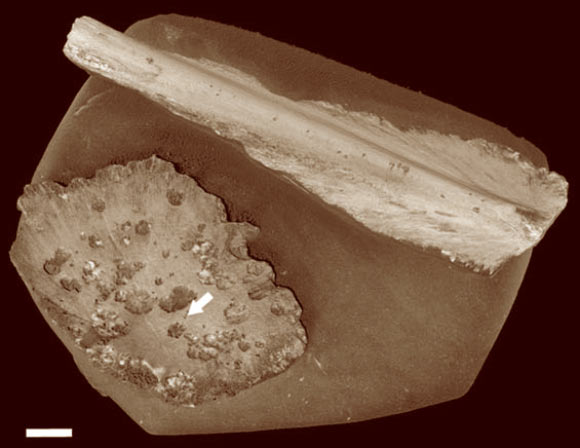In a new paper in the journal Biology Letters, scientists reported fossil traces of Osedax – a genus of bone-devouring worms that both eat and inhabit dead whale skeletons and other bones on the sea floor – from 100 million-year-old plesiosaur and sea turtle bones.

CT reconstruction of 100-million-year-ol sea turtle bones. Arrow indicates borings created by an ancient Osedax worm. Scale bar – 1 cm. Image credit: Silvia Danise / Nicholas Higgs.
Osedax worms, also known as boneworms, zombie worms, or bone-eating worms, were first discovered on a whale carcass in 2002.
There are more than 10 species that can be found in oceans across the globe at depths of up to 4 km. They belong to the worm family Siboglinidae (beard worms). Like all species in the family, they have no mouth, anus, or gut.
Typically, bone-eating worms grow up to 3-4 cm long. They consume whale bones, prompting many marine biologists to believe that they co-evolved 45 million years ago, branching out from their cousins that used chemosynthesis to obtain food.
But Dr Nicholas Higgs of Plymouth University, UK, and Dr Silvia Danise of the University of Georgia and Plymouth University, found that Osedax worms originated at least 100 million years ago, and subsisted on the bones of prehistoric reptiles such as plesiosaurs and sea turtles.
The scientists studied fossil fragments taken from a plesiosaur unearthed in Cambridge, and a sea turtle found in Burham, UK.
Using a computed tomography scanner, they were able to create a computer model of the bones, and found bore holes and cavities consistent with the burrowing technique of Osedax.

Modern Osedax worm (O. priapus). Scale bar – 0.3 mm. Image credit: Greg Rouse.
“The unusual adaptations and striking beauty of Osedax worms encapsulate the alien nature of deep-sea life in public imagination,” Dr Higgs said.
“And our discovery shows that these bone-eating worms did not co-evolve with whales, but that they also devoured the skeletons of large marine reptiles that dominated oceans in the age of the dinosaurs.”
“Osedax, therefore, prevented many skeletons from becoming fossilized, which might hamper our knowledge of these extinct leviathans.”
_____
Silvia Danise & Nicholas D. Higgs. Bone-eating Osedax worms lived on Mesozoic marine reptile deadfalls. Biology Letters, published online April 15, 2015; doi: 10.1098/rsbl.2015.0072







